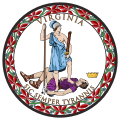| Secretary of Public Safety and Homeland Security of the Commonwealth of Virginia | |
|---|---|
 | |
 | |
Incumbent since July 25, 2025Marcus Anderson | |
| Style | Mr. Secretary |
| Member of | Virginia Governor's Cabinet |
| Nominator | The governor |
| Appointer | The governor with advice and consent from the Senate and House |
| Term length | 4 years |
| Inaugural holder | Wayne A. Whitham (as Secretary of Transportation and Public Safety) |
| Formation | April 8, 1972 |
| Website | pshs.virginia.gov |
The secretary of public safety and homeland security is a Virginia government executive that serves as a member of the Virginia Governor's Cabinet.
Contents
- Duties
- History
- List of secretaries
- Transportation and public safety (July 1, 1972–July 1, 1976)
- Public safety (July 1, 1976–July 1, 1984)
- Transportation and public safety (July 1, 1984–February 22, 1990)
- Public safety (February 22, 1990–April 2, 2014)
- Public safety and homeland security (April 2, 2014–present)
- References
- External links